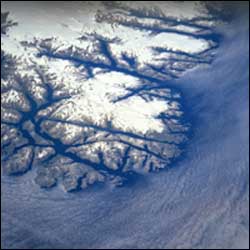Better measurements reveal seasonal changes in sulfur

Aerial view of the Greenland coast. Credit: NASA-JSC-ES&IA
Researchers from the University of Maryland (UMD) and the National Institute of Standards and Technology (NIST) have developed a new and improved technique for the simultaneous measurement of sulfur isotopic ratios and concentrations of atmospheric sulfate using snow samples from Greenland and Kyrgyzstan.
Sulfur plays an important role in the Earth’s climate. Sulfate particles in the atmosphere scatter and absorb sunlight, provide “seeds” for cloud formation, and affect the reflectivity and radiance of clouds, and thus the temperatures at the Earth’s surface. Atmospheric sulfate comes from natural sources, including oceans and volcanoes, but a large fraction comes from the burning of fossil fuels. Researchers can distinguish between various natural and anthropogenic sources in snow by measuring sulfur isotopes–forms of the element with different numbers of neutrons.
To study how these particulates have changed over time, scientists dig holes in snow that provide an archive of atmospheric particles deposited on the Earth’s surface. The standard analysis technique, gas-source isotope ratio mass spectroscopy (GIRMS), requires relatively large samples–up to four kilograms (about 9 pounds) of snow and ice, but the cycling of sulfur in the atmosphere is dynamic and variable, so samples this large blur seasonal changes.
To solve this problem, the UMD/NIST team developed a new analytical tool based on thermal ionization mass spectrometry (TIMS), which requires much smaller samples. The researchers used an advanced calibration technique known as double isotopic spiking to correct measurement drift and obtain isotope ratio measurements comparable to or better than GIRMS. The smaller snow samples required for TIMS make it possible to distinguish seasonal changes in sulfur particulate composition. The technique also can be used for making highly precise and accurate measurements of sulfur in low-sulfur fossil fuels, and similar applications.
Media Contact
More Information:
http://www.nist.govAll latest news from the category: Earth Sciences
Earth Sciences (also referred to as Geosciences), which deals with basic issues surrounding our planet, plays a vital role in the area of energy and raw materials supply.
Earth Sciences comprises subjects such as geology, geography, geological informatics, paleontology, mineralogy, petrography, crystallography, geophysics, geodesy, glaciology, cartography, photogrammetry, meteorology and seismology, early-warning systems, earthquake research and polar research.
Newest articles

A universal framework for spatial biology
SpatialData is a freely accessible tool to unify and integrate data from different omics technologies accounting for spatial information, which can provide holistic insights into health and disease. Biological processes…

How complex biological processes arise
A $20 million grant from the U.S. National Science Foundation (NSF) will support the establishment and operation of the National Synthesis Center for Emergence in the Molecular and Cellular Sciences (NCEMS) at…

Airborne single-photon lidar system achieves high-resolution 3D imaging
Compact, low-power system opens doors for photon-efficient drone and satellite-based environmental monitoring and mapping. Researchers have developed a compact and lightweight single-photon airborne lidar system that can acquire high-resolution 3D…





















